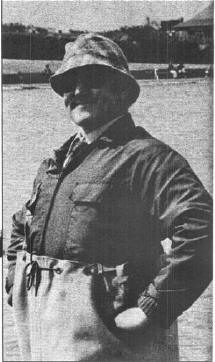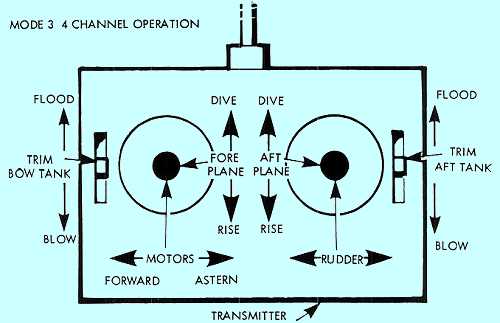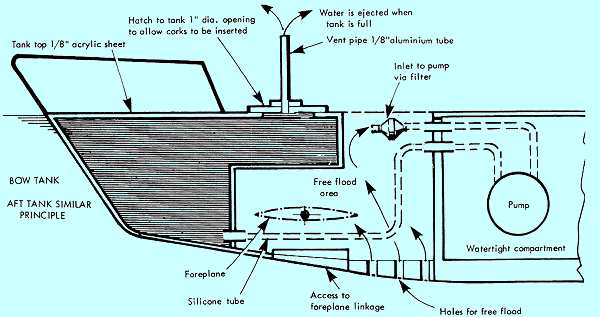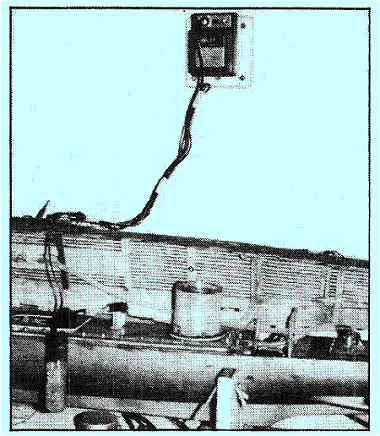|
U789
|
||
|
|
|
|
|
"Who is this man?" I hear, you ask." This quiet, modest brilliant genius, who so unselfishly places all these boating goodies before us?" Well, Kamerdan,. here I am. I have my faults, but being wrong is not one of them!" |
||
| Disaster ! | ||
| Submarines, as well as being lethal weapons, are also highly vulnerable craft due to their low reserve of buoyancy: Although they are subdivided into water tight compartments, the flooding of only one of these will sink the boat. And disasters can be caused by the most trivial things. When the WW II submarine Thetis went down, it was because a small inspection cock in a torpedo door was blocked with paint!. Calamity can come out of nowhere. | ||
|
U789 was doing fine. Placed on the water, the boat settled to diving trim as the pumps filled the tanks. We set off up the lake. The boat gently swam into the depths, and nosed along just like a big lazy fish.- The miniature Sargasso sea at the top end of the lake was not navigable submerged and I brought U789 to the surface and crossed the weed-infested area. Overhearing the admiring comments of passers-by, and drunk with success, I strutted proudly along the lakeside but did not notice that the boat was in distress until far too late. U789 was nose down, of its own accord. I strove to control the boat, applying full up to both planes, and tried to head for the side. But to no avail, she was headed for the deep. The drowning receiver on board sent a series of crazed commands to the servos and chaos reigned as a stream of bubbles emerged from the hull. "Donner and Blitzert!" I cried (this is what the Germans always used to say in the comics during the war when something unpleasant was about to happen to them, as it invariably did). |
||
|
The ultimate humiliation was at hand. The lake clutched U789 to its muddy bosom. With reckless gallantry, I jumped into the lake. (Something my critics have been telling me to do for years). A shrill scream escaped my lips as the chill October waters reached those parts which all beers finally reach, but I plunged onwards, still clutching my useless transmitter. I reached the wreck staggering wildly, and hooked my foot under the stern. I was able to lift it, and by putting my arm into the water up to the elbow I grasped the model and struggled with it to the side. It weighed about 7 tons. Few men are tougher than my good self. I mean, I can crunch Aspros without water, but this horrendous experience tested me to my limits. If I had not had the intelligence to promote myself to the rank of Kapitan for my courage and skill, I might well have had my 17th nervous breakdown since I started the U789. |
||
|
|
||
|
The cause of the disaster was simple. The vent tube, down which I regularly blew in order to cheek for leaks and to expel water via the bilge pipe, had come adrift. I used tin. length of silicone tube, '1/8in. bore, which fitted over a copper tube projecting through the front bulkhead. Unfortunately it did not project through far enough, only about 3/8in. The silicone tube had come off. The fault was soon remedied, but the point is, you have to look for possible trouble. Remember Murphy's Law, which states: 'If something can go wrong, it will'. I recommend the use of waterproof servos in these boats, as well. When I got home, I discovered, to my further displeasure, that two of the four servos in the boat had failed to survive their ordeal. In the next two weeks, a further two bit the dust, for no apparent reason. It was getting expensive. I dug deep into my junk box, and managed to contrive another full complement of servos, some of them dated back to about 1732. So far they have hung on grimly to life. |
||
|
In Conclusion So that is U789 in what is probably its final form. Looking back over what I have written, I hope I have not given too many false impressions. Some of the experiments I have described in a sentence or two were actually very time consuming. As regards the difficulty of staying on an even keel at the desired depth, well, it certainly is not easy. However, the water I practice in is no more than 3ft at the deepest, and most of the diving I do is about 5 yards from the lakeside, where I can see what's going on. But there are places in the lake where the water is often less than two feet deep and contains clumps of weed and boulders hurled in by the intelligentsia. So as well as looking at the pitch of your boat, you are also scanning the water 4 or 5 yards in front of the boat, this adds considerably to the problem. In a lake about 4ft. deep, free from obstacles, progress would probably be much more encouraging. |
||
| People often ask how deep the boat will dive. Well, Tynemouth is the only lake where I have sailed U789 and it is quit shallow. Club colleagues who also have submarines and have tried them in swimming pools mention that you lose radio control below 6ft. With me, depth of diving is of little interest, I get my kicks by having the boat prowl along just below the surface with just the periscope sticking up. | ||
|
Some time, I hope to build a real scale submarine, with a lovely bulgy hull, Norman Ough's E29 probably, and make a proper job of it. But I doubt if I'll be as fond of it as I am of the much battered and abused U789. |
||
|
|
||
|
At the outset of the submarine project, my ambition had been to dive the boat near the landing stage, and sail it submerged to the top end of the lake, a distance of about 180 yards. At first, the task seemed impossible, then one morning, it just happened, and I was hardly aware of it. So immersed was I in the job of dept keeping that I did not realise how far the boat had travelled until it arrived in the impenetrable patch of weed at the top end. My irritation at getting bogged down changed to elation as I realised the enormity of my success. Afterwards, in the pub, I rose to my feet, and addressed my club mates. "Kameraden, let us all drink a toast to the fabulous exploits of U789 and to the genius of her designer and commander, namely me!" |
||
|
There are, sadly, times when I despair for these uncouth Tynesiders. They do not deserve to have in their midst, men of culture, of diamond-sharp intellect, of high aesthetic, artistic and poetic stature, of brilliant engineering capabilities, like what I am. Here was a case in point. The bar was rent by their unseemly hilarity and their suggestions as to what I should do with U789 - all, needless to say, physically impossible. Such oafishness should surely be punished, But how? Mere words would been adequate. How do you punish a boat modeller` Well, you sink his boat. What a pity U7S9 could not fire torpedoes. But wait. . the trim movement on the motor servo is not serving any purpose at present. It could be used to withdraw a retaining pin, make a contact, launch a missile. A couple of cigar tubes, aluminium, joined end to end. An old servo motor, 20mm diameter. A long range, high speed missile was not necessary, nor even desirable. Their models often lay stopped in the middle of the lake while they chatted. That would be my chance. A few Weary old nicads would suffice to power the torpedo. I had plenty of them. It would be no good in rough conditions, the torpedo would go off course. |
||
|
A flat calm would be no good either, they would see the periscope as the boat made its approach. A light popple on the water would be ideal. Point blank range, say ten feet. Slowly the torpedo would make its way to the target while U789 absconded from the vicinity. I looked round the table. They were chatting amiably among themselves, unaware that one of the finest brains south of the Arctic Circle was plotting their doom, I allowed a cruel, sinister smile to play briefly across my lips, just like Lee Van Cleef in those westerns. What about a warhead? It was no good just tickling the victim's paintwork. We U-boat commanders must think big. A four-inch hole punched in the hull was on the agenda. Gelignite? No good, too hard to get. Home brew gunpowder? Maybe. What about fulminate of mercury, that should make a nice bang! I stood up, and with a dramatic gesture. swigged hook the remains of my vitamin enriched Ribena. . Unfortunately, some of it spilt down the front of my shirt. turning it purple. Never mind. I hurried home, to the drawing board. I really mean that, most Sincerely. "kind regards, bill Thompson." |
||
|
|
||
|
Charging and ventilating.
|
||



